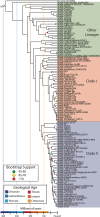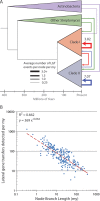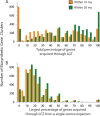Lateral Gene Transfer Dynamics in the Ancient Bacterial Genus Streptomyces
- PMID: 28588130
- PMCID: PMC5472806
- DOI: 10.1128/mBio.00644-17
Lateral Gene Transfer Dynamics in the Ancient Bacterial Genus Streptomyces
Abstract
Lateral gene transfer (LGT) profoundly shapes the evolution of bacterial lineages. LGT across disparate phylogenetic groups and genome content diversity between related organisms suggest a model of bacterial evolution that views LGT as rampant and promiscuous. It has even driven the argument that species concepts and tree-based phylogenetics cannot be applied to bacteria. Here, we show that acquisition and retention of genes through LGT are surprisingly rare in the ubiquitous and biomedically important bacterial genus Streptomyces Using a molecular clock, we estimate that the Streptomyces bacteria are ~380 million years old, indicating that this bacterial genus is as ancient as land vertebrates. Calibrating LGT rate to this geologic time span, we find that on average only 10 genes per million years were acquired and subsequently maintained. Over that same time span, Streptomyces accumulated thousands of point mutations. By explicitly incorporating evolutionary timescale into our analyses, we provide a dramatically different view on the dynamics of LGT and its impact on bacterial evolution.IMPORTANCE Tree-based phylogenetics and the use of species as units of diversity lie at the foundation of modern biology. In bacteria, these pillars of evolutionary theory have been called into question due to the observation of thousands of lateral gene transfer (LGT) events within and between lineages. Here, we show that acquisition and retention of genes through LGT are exceedingly rare in the bacterial genus Streptomyces, with merely one gene acquired in Streptomyces lineages every 100,000 years. These findings stand in contrast to the current assumption of rampant genetic exchange, which has become the dominant hypothesis used to explain bacterial diversity. Our results support a more nuanced understanding of genetic exchange, with LGT impacting evolution over short timescales but playing a significant role over long timescales. Deeper understanding of LGT provides new insight into the evolutionary history of life on Earth, as the vast majority of this history is microbial.
Keywords: antibiotics; evolutionary genomics; horizontal gene transfer; molecular clock; species concepts.
Copyright © 2017 McDonald and Currie.
Figures





References
-
- Rinke C, Schwientek P, Sczyrba A, Ivanova NN, Anderson IJ, Cheng JF, Darling AE, Malfatti S, Swan BK, Gies EA, Dodsworth JA, Hedlund BP, Tsiamis G, Sievert SM, Liu WT, Eisen JA, Hallam SJ, Kyrpides NC, Stepanauskas R, Rubin EM, Hugenholtz P, Woyke T. 2013. Insights into the phylogeny and coding potential of microbial dark matter. Nature 499:431–437. doi:10.1038/nature12352. - DOI - PubMed
Publication types
MeSH terms
Substances
Grants and funding
LinkOut - more resources
Full Text Sources
Other Literature Sources
